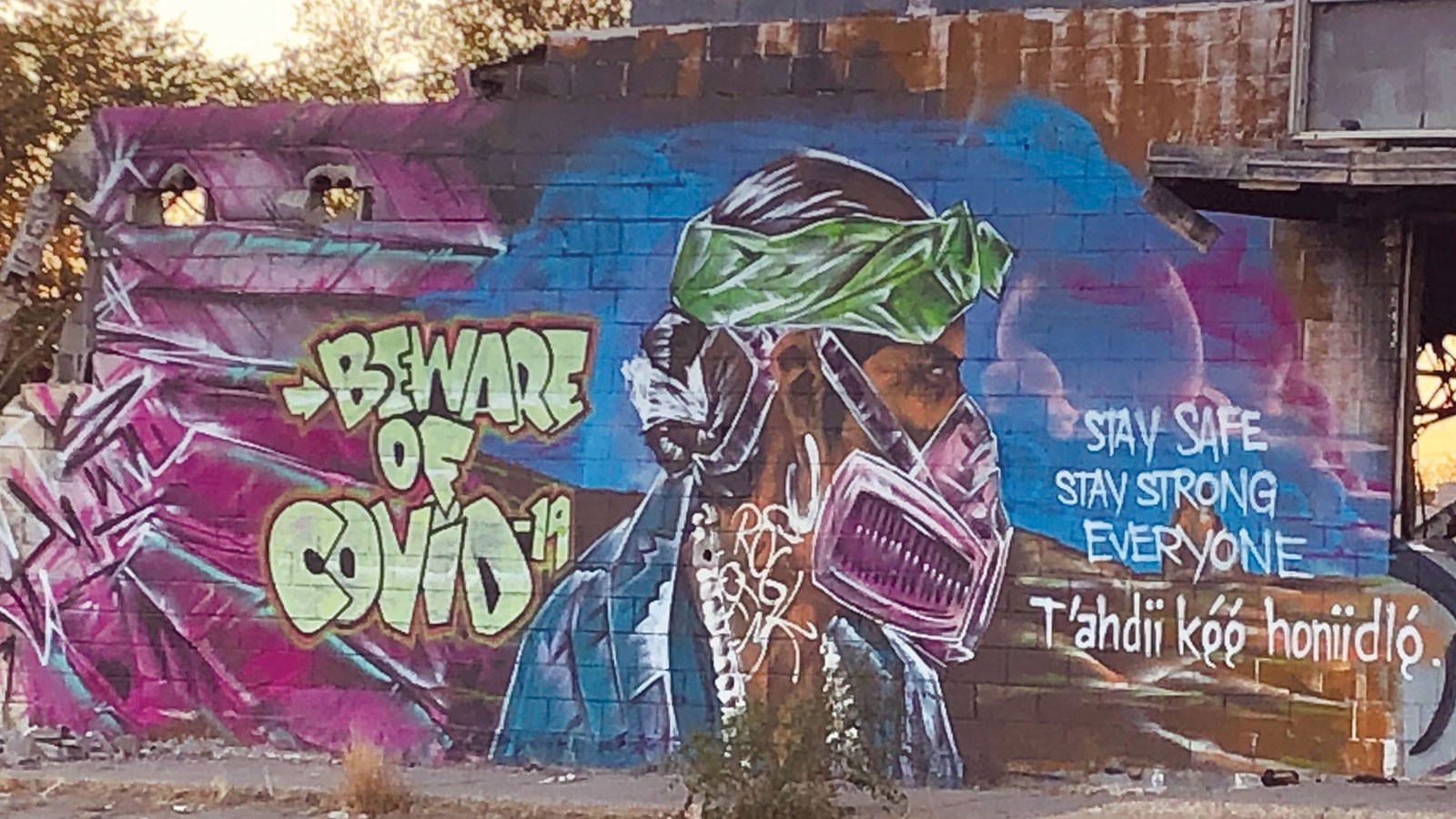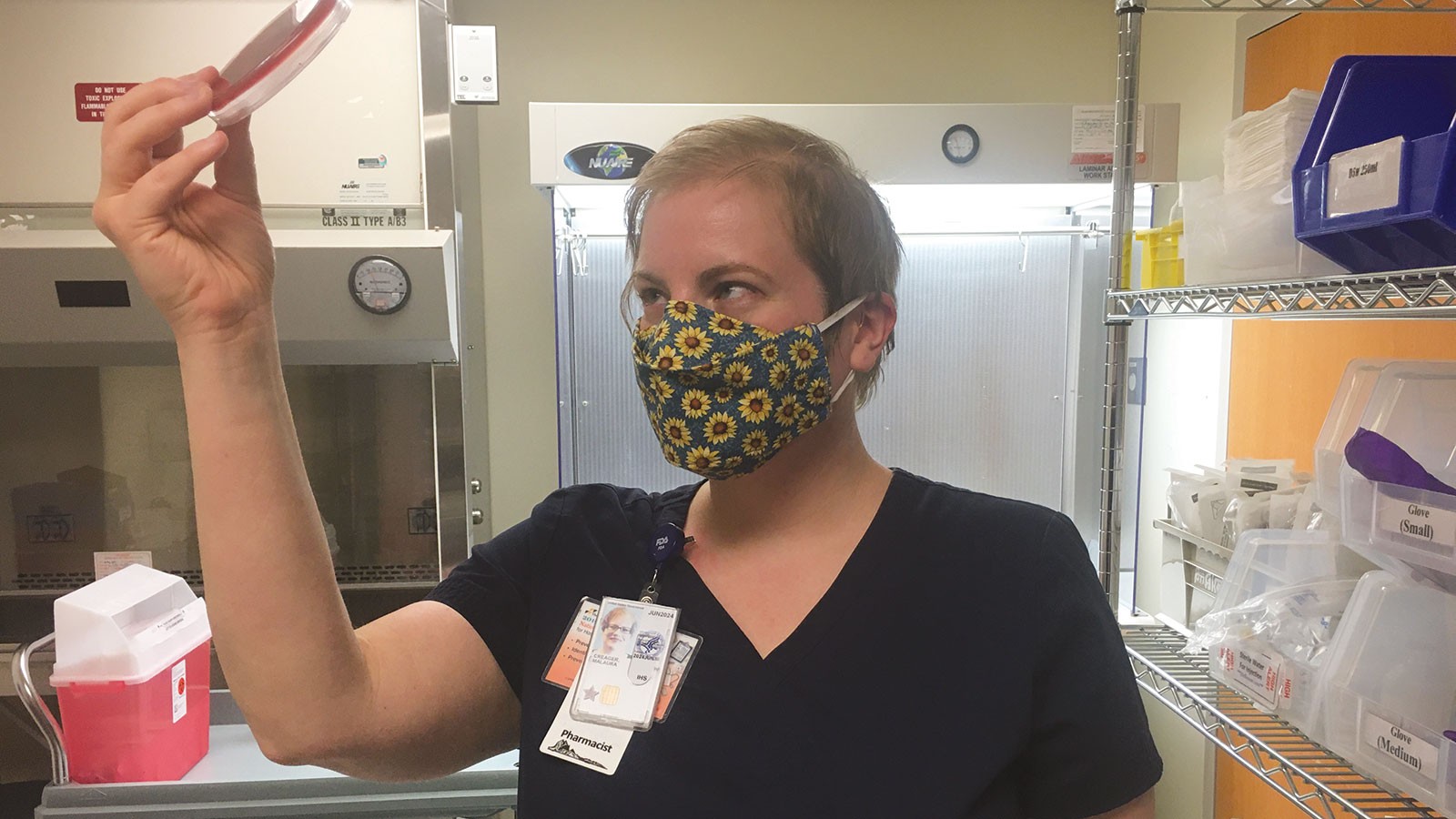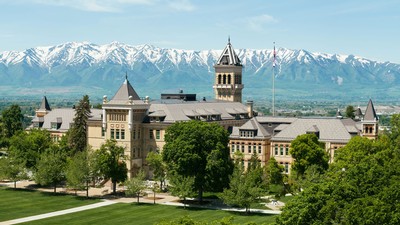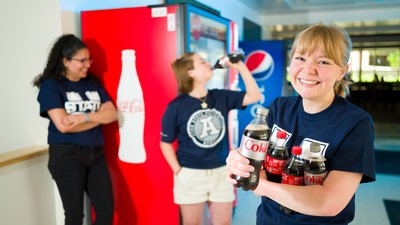USU Biology Alumna Finds the Right Chemistry Amid Pandemic Challenges
By Mary-Ann Muffoletto |
A mural in Shiprock, New Mexico, urges community members to 'stay safe, stay strong.' The Navajo Nation, where USU alumna MaLaura Creager is employed with the Indian Health Service, has been severely affected by the COVID-19 pandemic. MaLaura Creager.
While recently compounding a dose of Remdesivir, the antiviral medication used to treat COVID-19, pharmacist MaLaura Creager’s thoughts wandered back to her general chemistry class at Utah State. Creager, who earned a bachelor’s degree in biology with a minor in chemistry from USU in 2012, remembered faculty member John Hubbard’s lively demonstration of exothermic reactions.
“He kept us on the edge of our seats,” says Creager, a clinical pharmacist with the Indian Health Service in Shiprock, New Mexico. “Remdesivir causes an exothermic reaction as you compound it – it gets a little warm. But not hot enough to make me run from the building, as some of my classmates and I considered doing during some of Dr. Hubbard’s classes.”
On the front lines of the COVID-19 battle, Creager responds to daily challenges, but says experiences at Utah State prepared her well for a demanding career.
A Utah native, Creager graduated from Ogden High School in 1996, began clerking for a physician in Provo and set her sights on university studies.
“I have relatives in Cache Valley and, during childhood visits, we’d take walks on the USU campus,” she says. “I’d peer at those classroom and lab buildings and dream of going to college.”
The first-generation college student began her studies at Utah Valley University, but earned a transfer scholarship to Utah State.
“It wasn’t easy, as I’m a single mom of a special-needs daughter,” Creager says. “But the Department of Biology was wonderfully supportive.”
Faculty member and ornithologist Kimberly Sullivan was particularly instrumental in propelling the undergrad toward academic and research opportunities.
“I’m partially deaf, so it was difficult for me to hear and distinguish bird songs,” Creager says. “But Dr. Sullivan was very empowering. She showed me how to take advantage of my strengths. She also understood my challenges as a single parent and allowed me to study in her lab space.”
Anatomy and physiology lecturer Andy Anderson was also an important mentor.
“His class was tough, but prepared me well for pharmacy school,” she says. “Perhaps even more important was his counsel about making the best decisions for patients. I still use concepts from his lessons most every day.”
Chemistry became a favorite subject for Creager and factored into her decision to pursue pharmacy school. While an undergrad, she also shadowed a pharmacist at Logan’s Intermountain Healthcare InstaCare pharmacy.
“Though I was a biology major, I discovered chemistry, especially organic chemistry, was very intuitive for me,” she says. “I also enjoyed the computational challenges of biochemistry.”
Creager remembers an assignment during labs with Professor Lance Seefeldt’s biochemistry class, which involved computing a model with molecular binding tighter than that of the antiviral drug Tamiflu’s to the active site of the H1N1 influenza virus.
“I did it!” she says. “I think that surprised our lab instructor and that experience gave me a lot of confidence.”
Following graduation from Utah State, Creager was accepted to the University of Colorado’s Skaggs School of Pharmacy and Pharmaceutical Sciences, from which she earned a Doctor of Pharmacy degree in 2017. She completed a postgraduate residency with Albuquerque’s Lovelace Medical Center, before accepting a permanent position with the Washington, D.C.-based Indian Health Service.
“The IHS has a student loan forgiveness program, which is what initially piqued my interest – along with experiences shared by the pharmacist I shadowed at Logan InstaCare, who completed his residency at Northern Navajo Medical Center,” says Creager, who was assigned by INS to her current New Mexico post.
“But I soon discovered distinct advantages of this health care system from my own experiences.”
For one, her Shiprock post is an integrated hospital and clinic, which affords Creager the opportunity to interact directly with primary care and attending physicians.
“In many places in our country, health care is so fractured,” she says. “At our facility, my patients have integrated care and almost never slip between the cracks. I also have the opportunity to work closely with practitioners in many areas of specialty and be involved in patient care.”
With health care workers throughout the world, Creager has experienced the unrelenting demands of the COVID-19 pandemic, which has hit her area of the Four Corner region, a part of the more than 27,000-square-mile Navajo Nation, with ferocity.
“We started seeing patients with COVID-19 last March and quickly started changing routines, instituting added precautions and allocating resources more thoughtfully,” she says. “This proactive management and the community infectious control measures meant that we were not overwhelmed.”
While patients in the most critical condition were airlifted to larger facilities in Albuquerque and out-of-state, Creager and her colleagues found themselves on heightened alert and response.
“In the two previous years, I’d participated in two respiratory distress codes requiring rapid-sequence intubation,” she says. “As the pandemic progressed, we were performing one to five intubations per shift.”
During her off hours, Creager pored over the newest medical literature on SARS-CoV-2 and COVID-19.
“Some of the papers I was reading were barely 24 hours old,” she says.
Creager says getting sufficient PPE – personal protective gear – was a big concern during the early months of the pandemic.
“The demand across the country was so high, it was hard to get supplies,” she says. “But the local community responded immediately by sewing cloth masks, which alleviated some of the local demand and helped to preserve PPE needed for medical professionals.”
In addition, the community heeded calls for attention to basic hygiene – washing hands frequently (“Things we learned in general biology,” Creager says) – and obeying lockdown and curfew rules.
“In this culture, many people live in large, multi-generational households,” she says. “That’s part of the reason this area was been hit so hard by the pandemic.”
On the Navajo Nation, the largest reservation in the United States, the COVID-19 death toll per capita is higher than any state. Over the summer cases declined but, in recent months, as in other parts of the country, case numbers have surged again.
“It’s a dire situation and our struggle is far from over,” Creager says.
As a clinical pharmacist, she has direct access to patient charts and carefully reviews treatments and patient progress.
“Pharmacists are equally responsible for approving prescriptions as the physician prescribing them,” Creager says. “We’re kind of like a proofreading system for health care. I’m fortunate that I also have authority and access to monitor patients.”
That authority proved critical in recent cases, where Creager providing life-saving information.
“During my residency, I worked in inpatient psychiatry, where I was frequently assisting with drug overdoses and poison control,” she says. “We had a patient who drank hand sanitizer and I spotted an issue, while reviewing this patient’s basic blood chemistry. It didn’t look like a typical hand sanitizer exposure and I suspected methanol poisoning.”
Creager was right. The patient had used hand sanitizer formulated with methanol and accidentally ingested the toxic ingredient. Creager borrowed doses of an antidote from a facility in Gallup, New Mexico and her actions were well-timed. Just as she received the supplies, her facility received another patient presenting with methanol poisoning.
“It was kind of like being a secret hero,” she says. “Patients almost never know it, when a pharmacist protects them. I was thankful to be able to help save the lives of at least two people. I love my job.”
MaLaura Creager '12, a clinical pharmacist with the Indian Health Service in Shiprock, New Mexico, checks a blood agar plate for bacterial growth. With colleagues, Creager is on the COVID-19 pandemic's frontlines. Courtesy Indian Health Service.
Pharmacist MaLaura Creager, right, with her teenage daughter. The first-generation college graduate says navigating studies, as a single parent, was difficult, but she received friendly support from USU's faculty and staff. Courtesy MaLaura Creager.
WRITER
Mary-Ann Muffoletto
Public Relations Specialist
College of Science
435-797-3517
maryann.muffoletto@usu.edu
CONTACT
MaLaura Creager
Clinical Pharmacist
Indian Health Service
malaura.creager@gmail.com
TOPICS
Community 453stories Health 314stories Student Success 312stories Alumni 189stories Biology 170stories COVID-19 157storiesComments and questions regarding this article may be directed to the contact person listed on this page.











